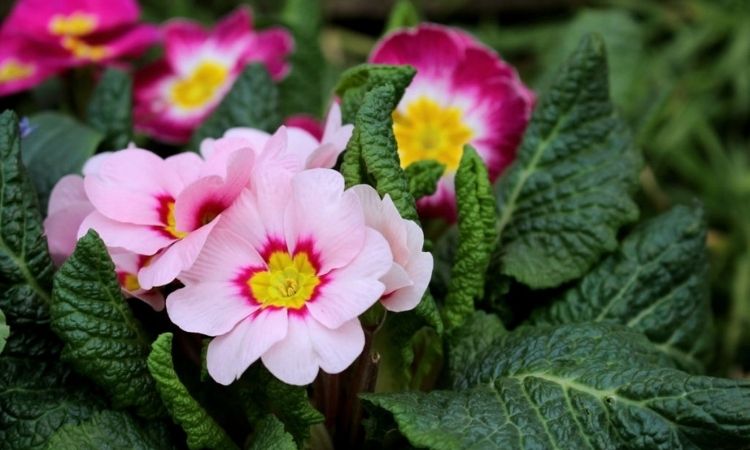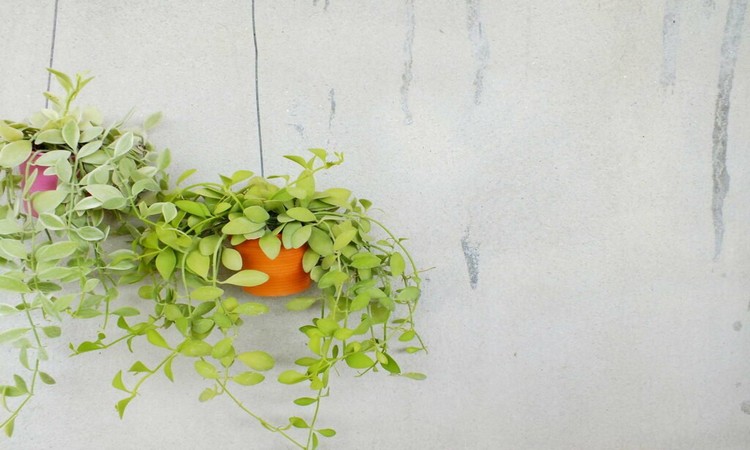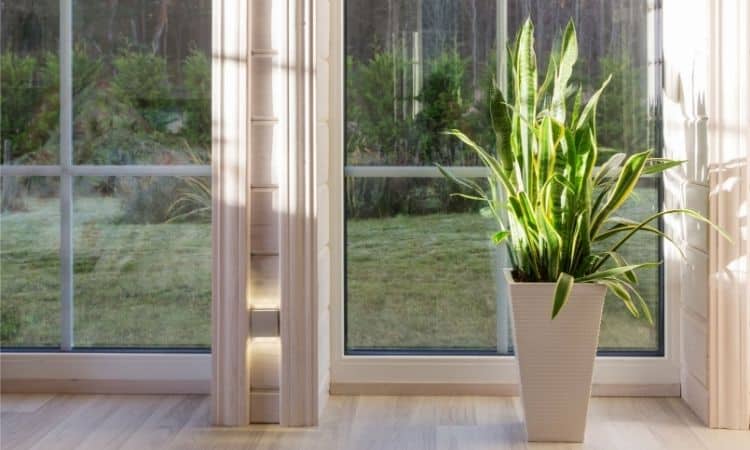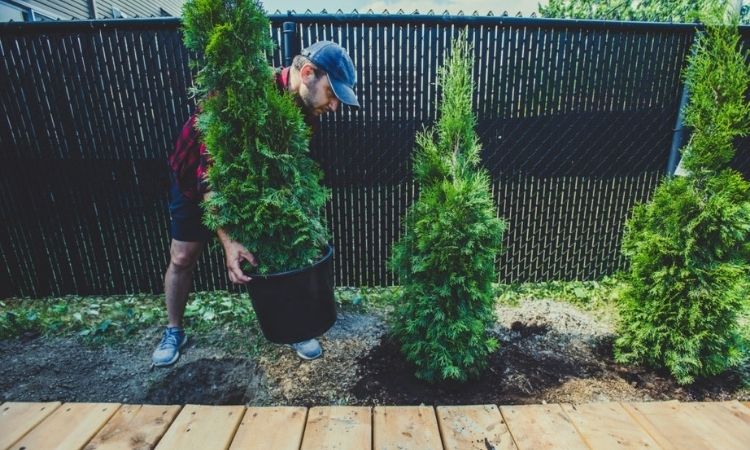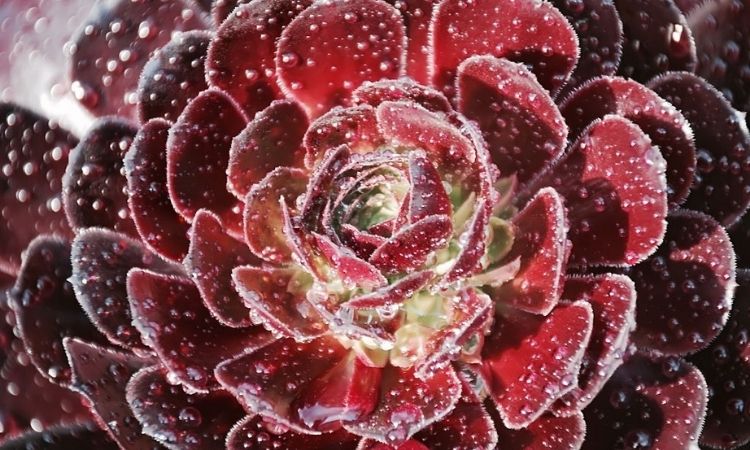Primrose (Primula)
The Primrose herb is part of the Primulaceae family. It comes from China. Primrose is quite widespread in culture, while it is grown both at home and in the open field.
This genus includes low-growing plants, the height of which does not exceed 25-30 centimeters. Wrinkled solid leaf plates with a surface covered with short hairs are collected in a compact socket. At the very beginning of the spring period, as soon as the snow melts, buds form on the tops of the leafless stems, which can be either single or included in the inflorescences that have an umbrella or racemose shape. Each flower contains 5 petals, which have grown together at the very base. Their color can be yellow, red, or white. Flowering begins in the spring and lasts until December or January.
The majority of primrose species are perennials with medium growth rates. Annuals and biennials are less common.
Brief Description Of Cultivation
Table of Contents
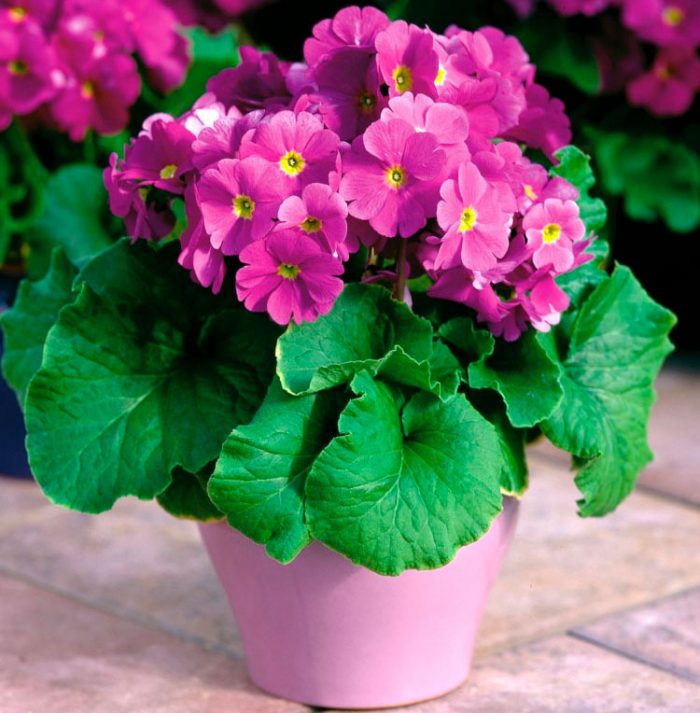
When growing room primrose, special attention should be paid to illumination, temperature, as well as the level of humidity.
- Temperature conditions. 12 to 18 degrees, the room should not be warmer than 20 degrees.
- Air humidity. If the air temperature in the room is within normal limits, then moderate air humidity will suit the plant. But if the room is warmer than 18 degrees, then the humidity should be increased.
- Illumination. In the summer, it needs a lot of diffused bright light. In the winter months, the bushes must be supplemented.
- Watering. The flowering bush is watered 2 or 3 times every 7 days. When flowering is over, watering is reduced to 1 or 2 times a week.
- Substrate. A well-drained, fertile soil mixture that can be acidic or neutral will do.
- Fertilizer. Topdressing is carried out 2 times a month, for this, they use liquid fertilizer.
- Transplant. In springtime, the new pot should be slightly larger than the old one.
- Reproduction. Seed and vegetative methods.
Please note that the primrose throughout the entire period of growth should be in conditions that are as similar to natural as possible. When the bush fades, it begins a dormant period, while a slowdown in its development is observed. To make the flower more powerful, in the spring it is transplanted into the garden, and with the onset of autumn, it is again transferred to a heated room.
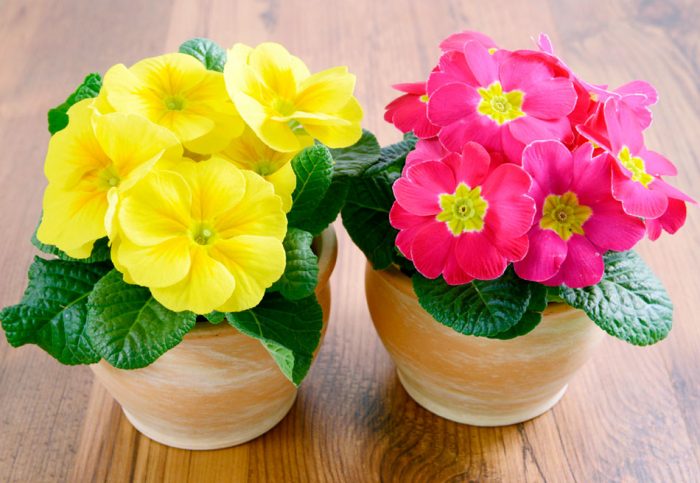
Primrose Care At Home
Planting primrose
When cultivating home primrose, planting is of great importance. How correctly it will be carried out directly affects the subsequent growth and development of the flower.
Before proceeding with the transplant, you should prepare:
- Suitable container. It should be low, wide, and medium in size. If the pot is very voluminous, then the bush will begin to actively build up the root system, which will negatively affect flowering.
- Substrate. A ready-made mixture for flowering plants, sold in a specialty store, is suitable. You can also cook it yourself by mixing greenhouse and leafy soil, and also sand (1: 1: 1). Be sure to disinfect the substrate by spilling it with a pink potassium manganese solution.
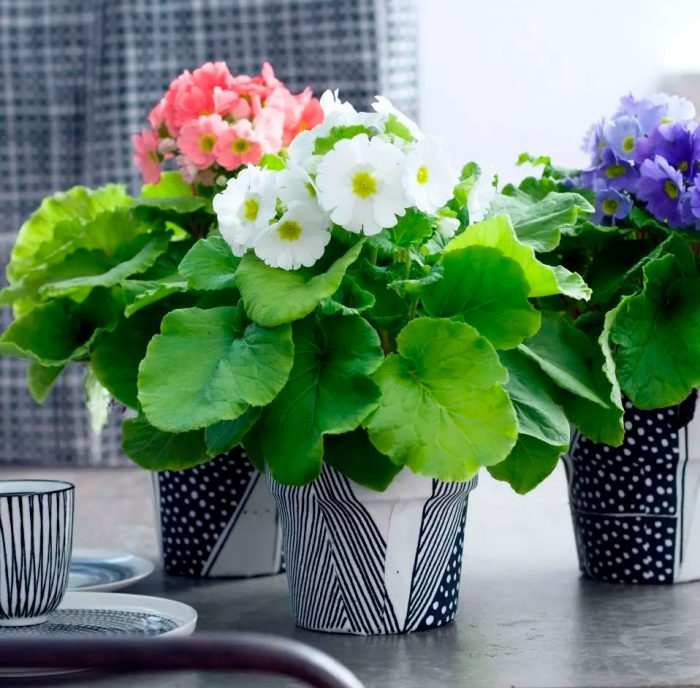
There is nothing difficult in planting a flower, the main thing is not to forget about simple rules:
- at the bottom of the container, be sure to make a drainage layer with a thickness of 15 to 20 mm;
- fill the drainage with a substrate, while not adding 10-15 mm to the top edge of the pot;
- make a small hole in the middle of the pot, the depth of which should be equal to the size of the plant’s root system;
- carefully place the root system in the hole and sprinkle it with soil mixture in such a way that the root collar is not buried;
- tamp the substrate a little against the stem.
The planted bush needs abundant watering. It is placed in a well-lit and cool place.
Bloom
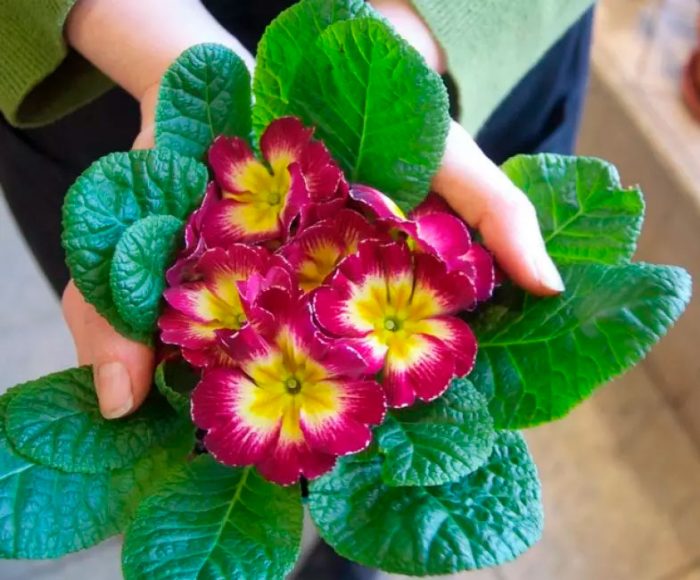
Most primrose species bloom very early, around April or May. Moreover, their flowering is quite long – from 8 to 12 weeks. But there are also such varieties, the flowering of which is observed only at the beginning of the spring period, for example, in April. At the same time, species related to thermophilic begin to bloom in June.
Temperature
In the summer months, the flower feels satisfactory at room temperature. And in winter, when the plant is dormant, it is placed in a cool place. If you do not observe the temperature regime, then the primrose may not bloom.
Air Humidity
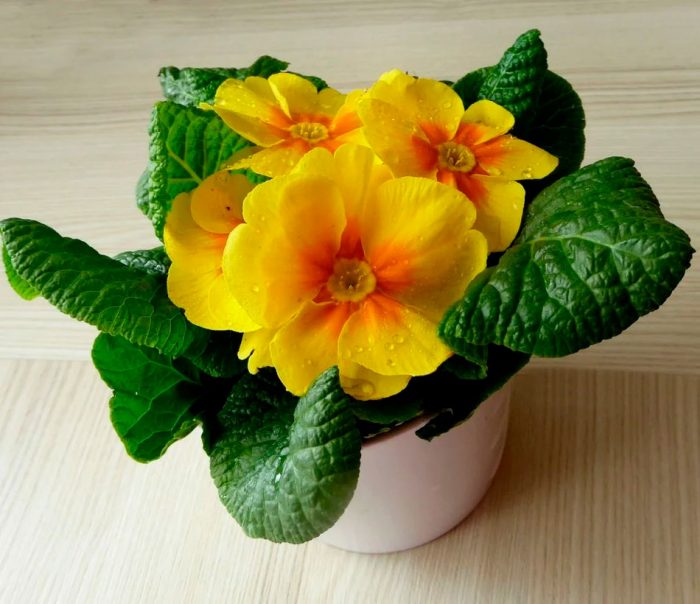
In indoor conditions, this culture is able to quickly adapt to any level of air humidity. But it should be borne in mind that with a long stay of a plant in a room with a low level of air humidity, the risk of a spider mite appears significantly. Therefore, it is recommended that indoor air is moderately humid.
To increase the level of humidity on hot summer days and in winter, when heating devices are working, it is necessary to pour moistened moss or expanded clay into the pallet. Instead, you can place an open container filled with water near the bush.
Illumination
Despite the fact that this plant is photophilous, it can be severely damaged by the scorching direct rays of the sun. That is why it is recommended to shade it from the sun during the summer months. In winter, primrose, on the other hand, needs direct sunlight and does not require shading.
Since the flower grows best in bright, diffused light, it is recommended to choose a window sill with a western or eastern orientation for it.
Watering

Home primrose needs to provide systematic moisture to the substrate. The frequency and abundance of watering directly depends on the stage of the growing season and the air temperature in the room, namely:
- during the flowering period, the substrate is moistened immediately after its surface dries to a depth of 10 to 15 mm;
- when the bush fades, watering should be moderate;
- in the winter months, when a dormant phase is observed in the flower, moistening of the soil mixture should be rare, it is carried out immediately after its surface dries to a depth of 30 mm;
- if the room is warm (20 degrees), then watering should be more abundant and frequent, but the liquid should not stagnate either in the substrate or in the pan.
For irrigation, use extremely soft water (passed through a filter or well-settled). Make sure that moisture does not get on the surface of the buds and leaf plates.
Fertilizer
During the growing season, feeding is not carried out. Only at the very end of flowering, fertilizers begin to be applied to the substrate. Top dressing is carried out 1 time in 1–1.5 weeks, while a solution of a mineral complex fertilizer is best suited, which contains at least 0.1 percent of ammonium nitrate. If the plant reacted negatively to fertilization, for example, it began to wither, then the concentration of the nutrient solution should be reduced by a third.
Primrose transplant
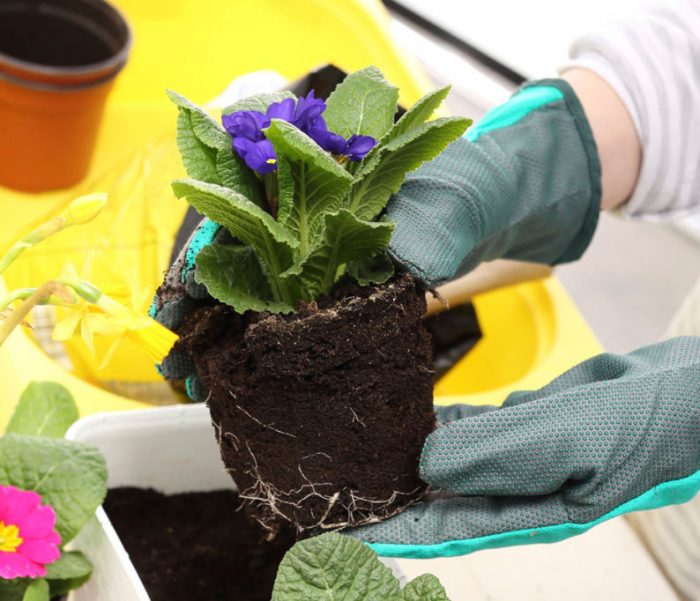
Indoor primrose needs a mandatory transplant. Moreover, the age of the bush affects the regularity of this procedure, for example:
- The transplant of a young plant is carried out systematically once a year in the spring. Remove the shrub from the pot and completely remove the substrate from the roots. Plant it in fresh potting soil, with the new pot slightly larger than the old one.
- A shrub that is more than three years old should be transplanted once every 2 or 3 years. In this case, the old container is replaced with a larger pot only if the bush has noticeably grown.
It may happen that the plant needs an urgent transplant. It is carried out only when:
- the root system becomes very cramped in the pot, and it looks out of the holes in the bottom of the pot;
- salting of soil mixture or stagnant moisture;
- rot appeared on the roots and the bush began to wither.
The transplanted primrose is watered and shaded from the sun for 3-5 days. You can understand that the bush is rooted by its foliage: it will restore its turgor, and its color will again become saturated.
Pruning
Pruning is not necessary for such a houseplant. But it is necessary to cut off flowers and leaf plates that have begun to fade in time. Thanks to this, the primrose will not waste energy on its development, and this will also help protect it from pests and diseases.
Reproduction methods
Cuttings
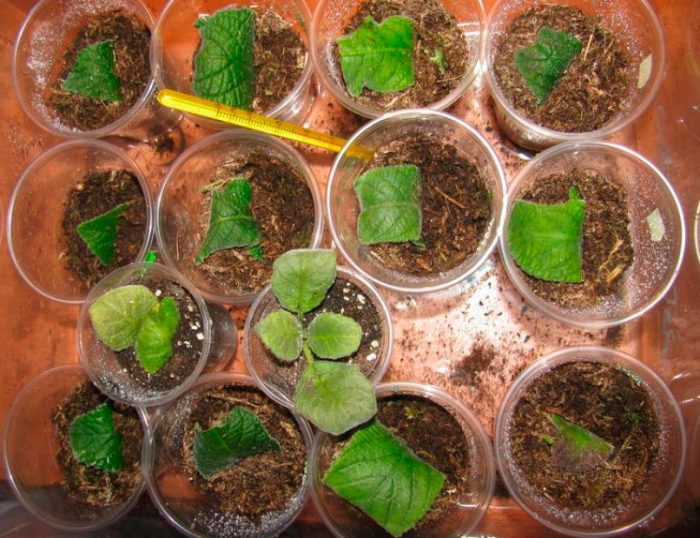
You can easily and quickly propagate homemade primrose by cuttings. Cuttings are harvested in May when the plant has faded. To do this, cut off the axillary leaf with the bud and part of the stem at the base of the leaf outlet. Such a segment will act as a cutting. For rooting, a low container is used, which is filled with a two-layer soil mixture:
- bottom layer – 20–25 mm of leaf or peat soil;
- the upper layer is coarse-grained river sand 20 mm thick.
Sections are planted with a bud upwards at an angle, deepening into the substrate by 10 mm. Then the cutting is transferred to a cool (16 to 18 degrees) and well-lit place while making sure that it is constantly moderately moist.
Young shoots should emerge from the buds after three months. When 3 or 4 young leaf plates grow on the cutting, it is transplanted into a separate container, reaching 7-9 centimeters across. For planting, a soil mixture is used, consisting of humus, deciduous soil, and sand (2: 4: 1). A bush that has grown from a cutting will bloom for the first time after about 6 months.
Growing from seeds
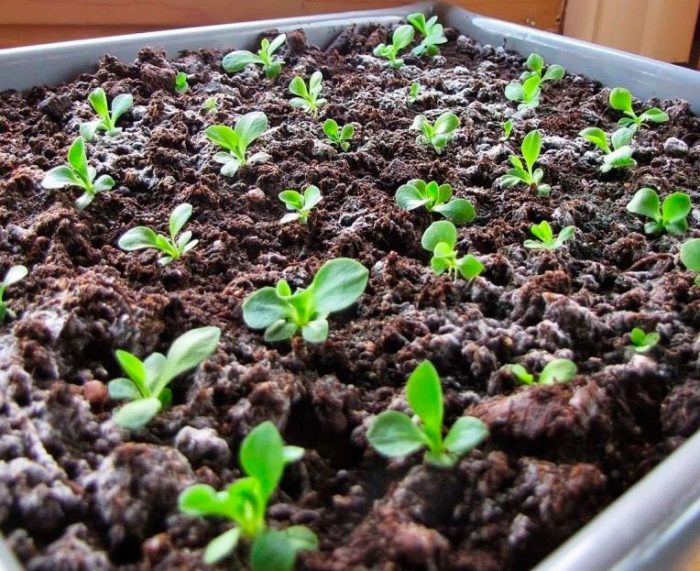
For propagation of primroses, the seed is used, purchased in a specialized store, or collected by hand. Springtime is great for sowing primrose, or rather, April or May.
Take a small box or bowl and fill it with a leafy-sandy substrate. One container is enough for 0.5 grams of seed. Moisten the substrate and sow the seeds so that they are evenly distributed over the surface. Cover the top with a transparent material that allows air to pass through. Move it to a well-lit place like a window. The first seedlings should appear after 10-12 days.
As the plants grow, they dive 2 times, after which they are planted in small individual pots (diameter from 70 to 90 mm). To do this, use a substrate consisting of sand, greenhouse, and deciduous soil (1: 2: 2). After the roots become cramped in the pot, the bushes are transplanted by transferring them into larger containers. For the first time, such primroses will bloom 6 months after sowing.
Possible Problems

Most often, problems with room primrose arise if it is improperly looked after or does not provide optimal conditions for growth. For example:
- Yellowing of foliage. Low air humidity in the room, liquid stagnates in the substrate, hard water is used to moisten the soil mixture, or the bush was fed with a highly concentrated nutrient solution.
- The rot has appeared on the leaf plates. During irrigation, water regularly gets on the foliage, or moisture stagnation in the substrate is observed for a long time at high air humidity.
- Rapid wilting of flowers. The room has extremely low humidity and high temperature (more than 20 degrees) of the air.
- Lack of flowering. During wintering, the bush was warm (over 20 degrees).
A bush that has weakened due to poor care can be easily affected by a fungal disease:
- Spotting. Most often, plants with a thickened leaf outlet, which are over-watered, get sick. In a diseased bush, gray spots are formed on the surface of the leaves and peduncles, which after a while become covered with bloom.
- Ramulariasis. Primrose, which is in a cool room, and in which moisture regularly stagnates in the substrate, is prone to its development. First, yellowish specks of a round shape appear on the foliage of the diseased plant. Over time, they become darker and rot appears. This becomes the cause of the death of the whole leaf plate and leads to the death of the entire bush.
To save a primrose affected by a fungal disease, it is necessary to cut off all diseased parts, after which the bush is treated with Topsin or Fundozol. It will take several treatments.
Pests such as scale insects, weevils, aphids, thrips, and spider mites can settle on the plant. While there are few pests, you can get rid of them with the help of folk remedies. Otherwise, it will be necessary to carry out the treatment with an insecticidal solution.
Types of primrose with photo
There are about 500 species of primrose. At the same time, not all species are cultivated at home.
Primula obconica
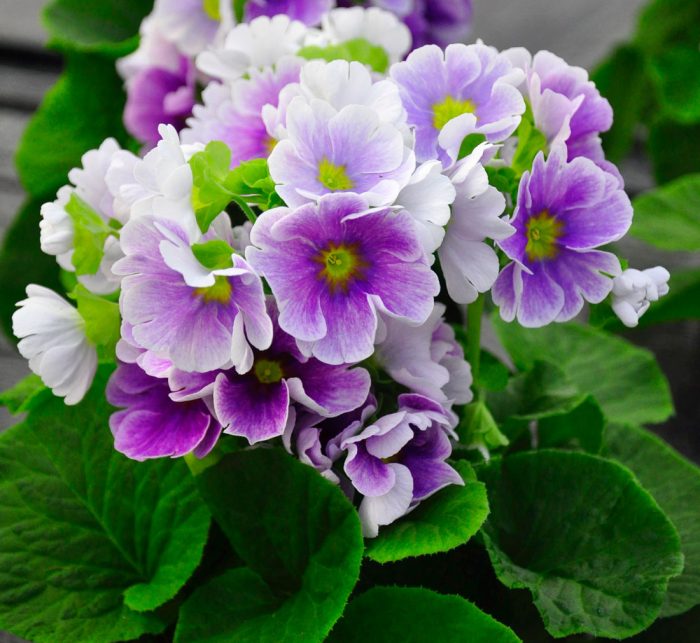
This herbaceous perennial plant reaches a height of about 0.6 m. The heart-shaped rough leaf plates reach about 10 cm in length, they have a wavy edge and a long petiole. The foliage is collected in a dense rosette. During flowering, an umbrella-shaped inflorescence appears, which consists of flowers of various colors, reaching from 30 to 40 mm in diameter. They have a pleasant, subtle aroma.
Primula Malakoides
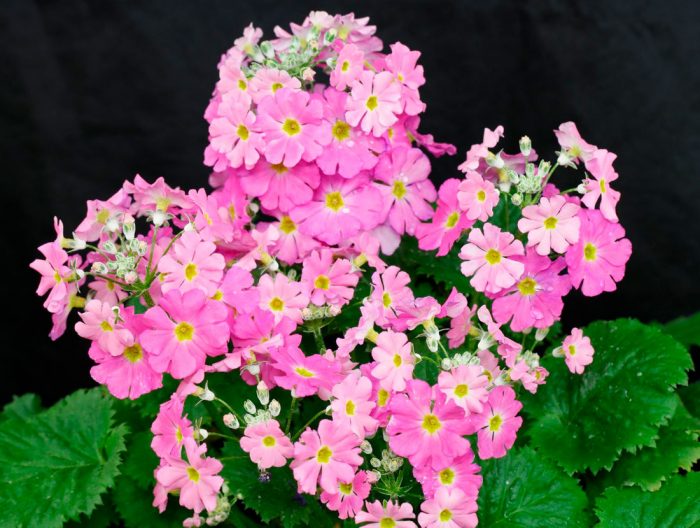
The height of such an annual is about 0.4–0.45 m. Elongated oval leaf plates with a serrated edge are assembled into an elastic dense rosette. Flowering begins at the end of November. At this time, about 8 long peduncles can form on the bush, on the tops of which whorls of long-tiered inflorescences are formed. They include about 45 small flowers, reaching up to 15 mm in diameter. The color of the flowers can be red, pink, or white, while they are often decorated with strokes, specks, or a yellow center.
Common primrose, or stemless Primula vulgaris
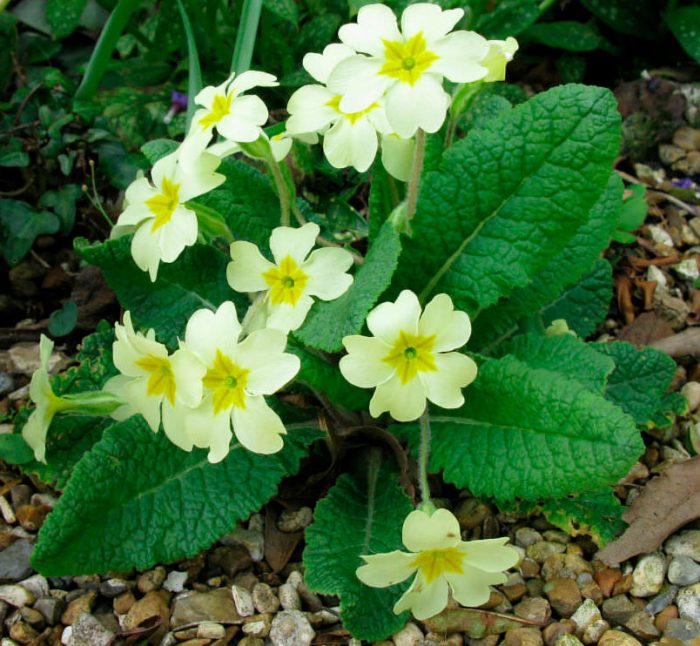
The species has many hybrids. They are distinguished by a lush leaf rosette, consisting of wrinkled foliage of an elongated oval shape. In the central part of each leaf plate, feathery venation is clearly visible. Flowering occurs in early spring for 20-30 days. At the tops of relatively short peduncles, single large flowers are formed, reaching from 20 to 40 mm in diameter. They can be painted in lilac-blue, yellow, snow white, red, and burgundy. This species is the most common in culture, and it can be grown both at home and in the garden.
Beneficial features
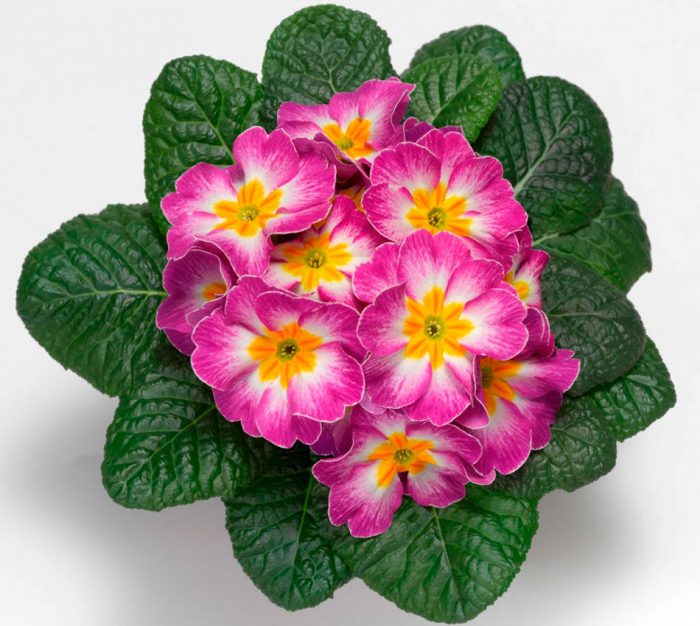
In alternative medicine, primrose has become quite widespread, and each of the parts of this useful plant is used:
- decoctions made from foliage help with respiratory diseases;
- the roots are used to prepare an infusion, which has a mild sweat and diuretic, as well as an expectorant effect, in addition, it helps to increase the metabolic rate and improve the functioning of the stomach;
- tea is prepared from the inflorescences, strengthening the nervous system.
The young foliage of such a plant is used in the preparation of soups and salads, while the dried crushed roots are used as a spice.
